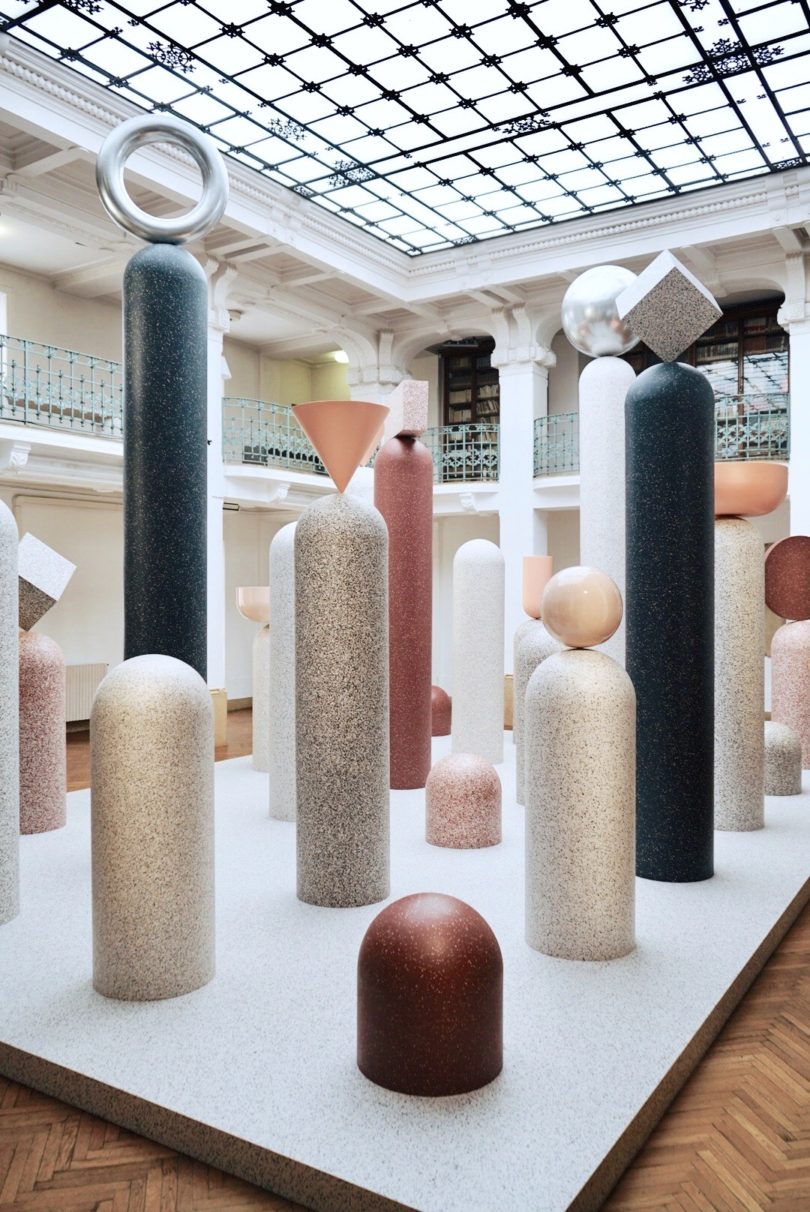Milan Design Week concluded on Sunday, April 14th last week. Thereafter, installations were brought down, showrooms shuttered. But if design weeks are about brands and designers putting their most attractive foot forward to lure in clients and the crowd, then these eye-catching installations, short-lived as they are, have succeeded in their mission of creating an awareness of the people and studios behind them.

Tarkett and Magis exhibit at the Circolo Filologico with help from Swedish designers at Note Design Studio. Photo by Keshia Badalge.
Formations, inside the historic Milanese library Circolo Filologico, showcases all the ways that French floor and wall covering company Tarkett’s new iQ Surface material can be molded, bent, shaped, and used to furnish all kinds of spaces. The Stockholm-based Note Design Studio worked with Tarkett to conceive of something certainly noteworthy here: under a glass roof, in a spacious lobby, 24 speckled columns in shades of red, navy, white, and grey are topped with silver spheres, coral cubes, cones, spheres, and other assorted totems.

Table with shapes exhibiting Tarkett’s moldability at the library of Circolo Filologico. Photo by Keshia Badalge.
It’s an exercise in subtle showing off: instead of exhibiting how Tarkett’s new vinyl flooring can be used in various domestic roomscapes, the sculptural installation invites people to touch, play, and even rest. Yes, rest: one of the most important things a design exhibition can do, at Milan Design Week, is to create a space for visitors to slow down, rest, charge their phones, and just take in the sight of something without having to explicitly interact with it.
Aesthetics aside, the iQ surface is actually made from a quarter of recycled materials. At the end of the installation, the surface can be taken back and reused for the future.

In a cozy meeting room setting in the Circolo Filologico, Tarkett’s surfaces meet Magis’ furniture. Photo by Keshia Badalge.
Whether wandering through the Sala Liberty, or into one of the meetings rooms Tarkett designed with iQ Surface flooring and Magis’ furniture, or through the library room where smaller volumes are wrapped in iQ Surface to show—up close—the possibilities that this material can be made into, we never felt like there was something being sold to us. It felt more like a sculpture park or an art gallery, something made for pleasure rather than for purchase, and that pretty terrazzo-like surface has been stuck in our minds since.
In Sala Reale at Milan Central Station, Advantage Austria, created by architects Michael Vasku and Andreas Klug, transformed what was once the waiting room of the Royal House of Savoy into a “design pool.” All day, we saw visitors wade, run, swim, roll, bellyflop, through a sea of foam that was interspersed with designer objects propped on lavender colored pedestals. Groups came in to sleep within the styrofoam puddles and create styrofoam showers for their Instagram photos. One suggestion, though: what gives pleasure might not be the world’s treasure. Foam isn’t the most environmentally sustainable material, and while we’ll remember this approach to presentation, maybe there can be something else to shimmy through next year that won’t sit in the landfill for centuries after.
Nilufar Depot’s exhibition FAR, created by Studio Vedèt with exhibition design by Genoa-based Space Caviar, creates a fluid galaxy with habitable, translucent membranes. Elevated gobbles, injected with furniture, surround an open wide floor that doubles as a gallery space for some quaint, colorful designer objects. Whether you’re a bubble person or someone more down-to-the-floor, this place was made to delight.
For heated tobacco/vaping brand IQOS, British sculptor Alex Chinneck employed his signature rip/unzip effect to a building in Milan’s Tortona district. As the building’s 17-meter-wide wall appears to fall off, the interior layer reveals a blue light, similar to a vape pen that illuminates the street at night. The interiors of the building feature the same style replicated on the walls and the floor.
Even though these installations have a life of only a week, they’ve set people talking about the brands who helped to conceive them, and in Milan, it’s not just all the high-end sofas and designer lamps we see that’s important, it’s what’s left on our minds a week after that counts.
from Design MilkArt – Design Milk http://bit.ly/2XCLQHu












































